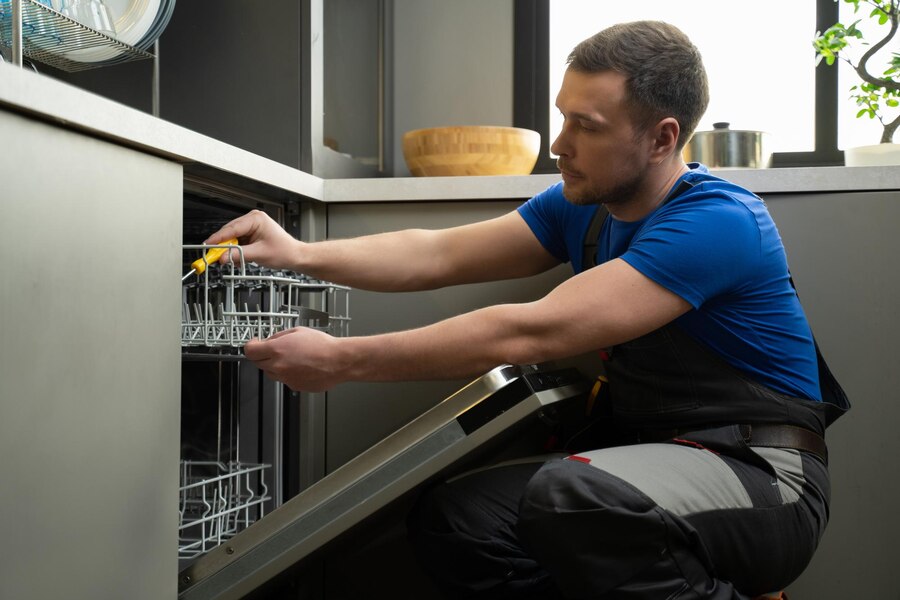Facing frequent dishwasher malfunctions? Don’t fret! This guide empowers you to become your own dishwasher troubleshooter, saving you time and money.
Packed with valuable dishwasher troubleshooting tips, it equips you to handle common issues like dishwasher filter stuck problems and address concerns like a dishwasher not getting hot. Before we tackle these challenges together, let’s understand:
What Are The Common Dishwasher Problems?
Your dishwasher is meant to make your life easier by effortlessly cleaning the dishes. However, there may come a time when it won’t meet the expectations due to different issues.
Addressing common dishwasher malfunctions, such as a non-functional heater or the dishwasher not starting independently, requires a systematic approach. By identifying the specific issue (dishwasher heater not working, dishwasher not starting), you can employ targeted troubleshooting steps.
To answer your question, “how to fix my dishwasher?” review the following common problems and their associated solutions.
A. Failure To Start
Possible Causes: A dishwasher failing to start is a common problem, and there might be various reasons, including power supply issues, a dodgy door latch, or glitches in the control panel.
Troubleshooting Steps:
- Check the power supply by ensuring the dishwasher is plugged in, and the circuit breaker isn’t tripped.
- Inspect the door latch to ensure it’s snug
- Glance at the display of the control panel a for any error codes or indications of malfunction.
DIY Fixes:
- If it’s a power supply issue, try resetting the circuit breaker or replacing the fuse.
- For a wonky door latch, tighten up any loose screws
B. Poor Cleaning Performance:
Possible Causes: If your dishwasher is not getting cleaned as it should, there could be various reasons, such as clogged spray arms or water that’s not hot enough to do the job right.
Troubleshooting Steps:
- Take a look at the spray arms and clear them properly if anything is blocking them.
- Check the water temperature. Is it hot enough for a thorough cleaning? For optimal results, aim for around 60°C – 70°C
DIY Cleaning Method:
- To keep those spray arms in top condition, remove them and soak them in warm, soapy water to remove any buildup.
- Run an empty cycle with a dishwasher cleaner to banish any lingering residue and keep your dishwasher running smoothly
C. Leaking:
Possible Causes: If you notice water pooling around your dishwasher, it could come from various places. Thus, you need to have dishwasher overflow fixes ready. Check the door seal to see if it is worn or damaged, and inspect the hoses and connections for any signs of leakage.
Troubleshooting Steps:
- Take a close look at the door seal. If you see any cracks or tears, it might be time for a replacement.
- Check the hoses and connections for any leaks or loose fittings, and then tighten or replace them if needed.
DIY methods:
- If the door seal is the culprit, you can often replace it yourself with a new one. Just make sure to get the right size for your dishwasher model.
- For leaking hoses or connections, tighten any loose fittings or replace damaged parts. And don’t forget to turn off the water supply before you start tinkering!
D. Noisy Operation
Possible Causes: If your dishwasher is making louder noises than your dinner conversations, the culprit could be worn-out parts, loose components, or issues with the motor or pump.
Troubleshooting Steps:
- Take a look at the dishwasher to see if there are any loose items or debris.
- Inspect key components, such as the motor, pump, or spray arms, for signs of wear and tear.
DIY methods:
- Tighten up any loose or worn-out parts to help quiet down your dishwasher.
- Lubricate moving components like the motor or pump to reduce friction and minimise noise.
- Regular maintenance checks can go a long way in preventing noisy operations.
E. Dishes not drying properly
Possible Causes: If you’ve encountered dishes that are not fully dry after a dishwasher cycle, there are several potential causes. These can include improper loading of the dishwasher or a malfunctioning heating element.
Troubleshooting Steps:
- Check thedishwasher heating element to see if it is functioning properly. A malfunctioning element might not generate enough heat to dry your dishes effectively.
- Ensure you are loading your dishwasher correctly, leaving enough space between dishes for air circulation.
DIY methods:
- If the heating element is the culprit, consider replacing it to restore optimal drying performance.
- If available, adjust your dishwasher settings to include a heated drying cycle. This can help ensure dishes come out dry and ready to put away.
When To Call In The Professionals?
Safety is paramount when troubleshooting dishwasher problems, whether it is a dishwasher heater not working or a dishwasher filter is stuck. This is why seeking professional assistance is crucial, especially when dealing with electrical components or intricate repairs, get it fixed by a reputable company that employ experienced skilled technicians. Get the repairs done once and get it right.
Call for reliable and professional dishwasher repairers, Ideal Refrigeration & Appliance Services at 0428 149 923 today.
Conclusion:
Minor dishwasher inconveniences, such as a stuck drawer or a Heater of a dishwasher not drying, can be dealt with by DIY methods. However, when it comes to getting your dishwasher back on track effectively, professional assistance is highly recommended. Don’t let the dishwasher dilemma interrupt your routine; take action today to get a fully functional appliance.
Restore the convenience of clean dishes with our professional dishwasher repairs in Brisbane, and Call 0428 149 923 today, to book in repairs at your convenience.


